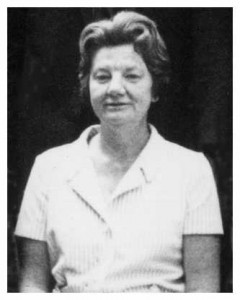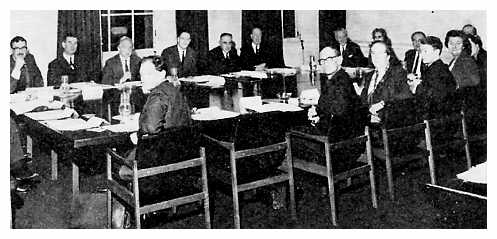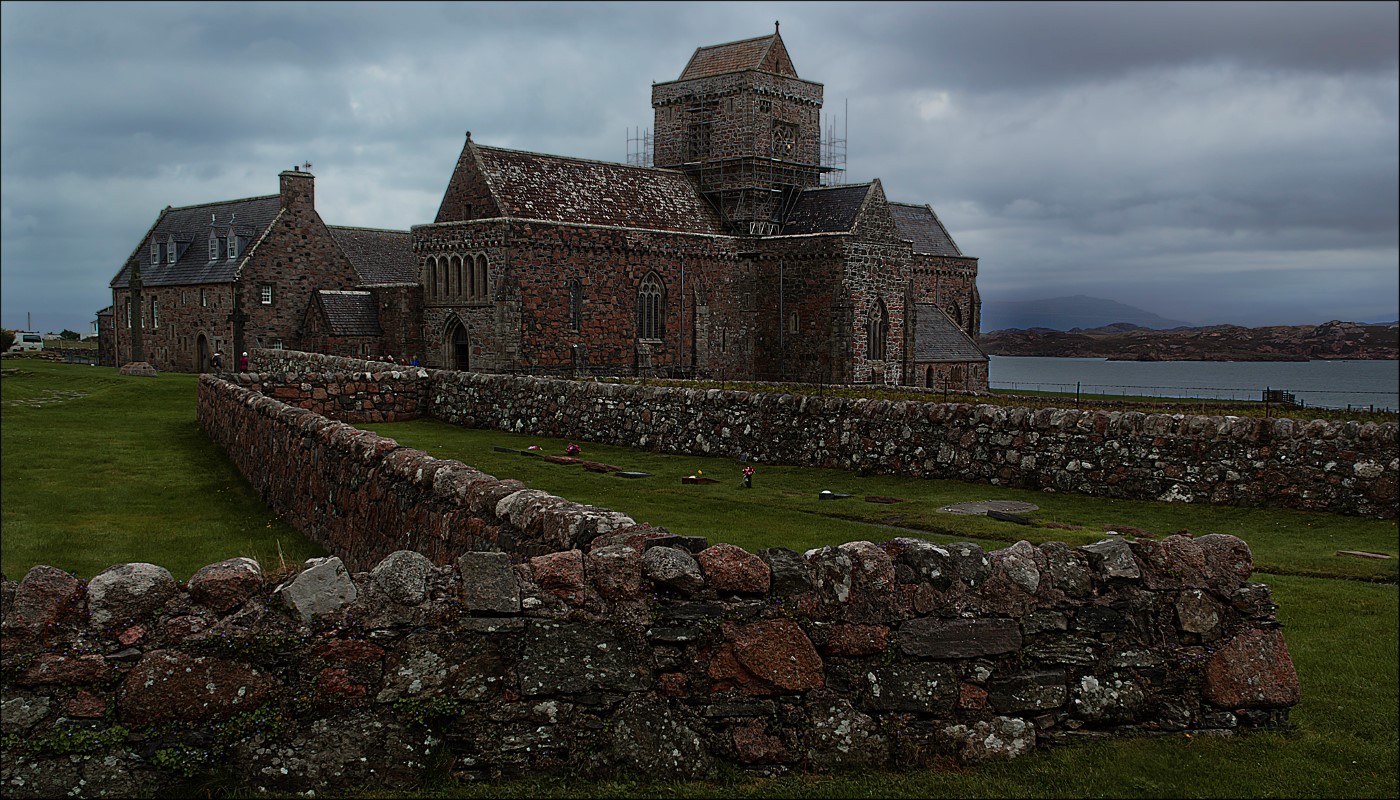Joan Tash made a lasting contribution to our understanding of the process of youth work and informal education. She pioneered the use of supervision; deepened our appreciation of detached and project-based youth work; and made a number of innovations in the training and development of youth workers and informal educators.
contents: introduction · life · working with unattached youth · joan tash on supervision · developing youth workers and informal educators · conclusion · further reading and references · how to cite this article
Opening image: Joan Tash had a long associaton with the Iona Community – picture of the abbey cloisters by Geoff Sowrey | flickr ccbync2
_______
Muriel Joan Tash (1920-2005) was a key figure in the development of supervision practise within youth work and informal education more generally. Along with George Goetschius she also produced the classic exploration of detached youth work – Working with Unattached Youth. One of the hallmarks of her approach was careful attention to process, and to the thoughts and feelings of the worker. As well as being a highly accomplished supervisor she was a gifted teacher. As the senior tutor at the YMCA National College in the 1970s, she was to develop an approach to educating and learning that had a particular resonance in the youth and community work field in the UK.
Life

In 1950 Joan Tash moved to in Baghdad for the YWCA to train Iraqi workers. On her return after four years service, she was at Newcastle YWCA for a time before joining the staff of the London YWCA. She became the area training and programme secretary. Tash had developed a particular interest in group work and was one of the small group whom John Spencer and Peter Kuenstler invited to a residential seminar, probably the first in the UK on the topic of group work. They had organized the event to take advantage of the presence in England of Grace Coyle, the key US writer on group work at the time (Kuenstler 2007; see, also, Kuenstler 1955). Sometime later Peter Kuenstler mentioned to her that he and Merfyn Turner had, for some time, been trying to find a site for a coffee stall project with ‘unclubbable’ youth. They had bought a mobile stall but could not get permission to open it on a suitable site because of the interlocking bureaucracy of the police and the London borough councils. Joan Tash and her chairwoman took the matter up through contacts in the YWCA and were able to find a way through and set up a twelve-month experimental project in 1959 (the YWCA London Coffee Stall Project) (Kuenstler 2007). Within a few months, they gained grant aid from the English Ministry of Education for three years to develop the project.
Joan Tash was seconded half-time to be the administrator/supervisor to the project. There she joined George Goetschius (whom Kuenstler had known from initially meeting him at an international conference on settlements held in Berlin 1952). Goetschius was to be the training and research consultant. The result was a five-year exploration of project and detached work with young people (with three years of intensive fieldwork) and the influential text, Working with Unattached Youth (Goetschius and Tash 1967). While still working on the project Tash became involved in the training of general secretaries and youth workers at the YMCA. Her specialism, not surprisingly, was group dynamics.
In 1964 Joan Tash moved to the London Council of Social Service as the tutor/supervisor on a project exploring the potential and role of supervision within youth work. The project, again, turned out to be very significant. It demonstrated the contribution that supervision could make to the enhancement of practice, and deepened appreciation within youth work and beyond of the processes involved. The impact made by the project was, in part, down to the fact that ‘non-managerial’ supervision in the form explored by Tash offered a clear and obvious way forward with regard to the development of workers in the field. However, much of the success of the project lay in the ability of Tash as a trainer and teacher, and in the quality of her research and write-up (published as Supervision in Youth Work in 1967).
Tash’s reputation had become well known within British youth service circles and she was invited to join the Youth Service Development Council in 1965 (along with other significant trainers such as Joan Matthews, Josephine Klein and Fred Milson). She became part of the Fairbairn Committee exploring the relationship of the youth service to schools and further education (reported as part of Youth and Community Work in the 70s) (DES 1969).
Youth Service Development Council circa 1966
Following on from the supervision project, Joan Tash continued to work part-time for the YMCA training general secretaries, but with the extension of youth work training to two years, and the establishment of the YMCA National College to accommodate the change in direction of training suggested by the Fairbairn-Milson Report (Youth and Community Work in the 70s), Tash was approached to become the senior tutor – which she did in 1970. There she was responsible for group work, practical work (including supervision) and student tutorials. She also supervised other tutorial staff. She continued in this role full-time until September 1978, and for a short while after that as a part-time tutor. In her retirement, she continued to be a much sought-after supervisor.
Joan Tash lived for over 30 years on Hampstead Heath (at 9, Vale of Health). The house had beautiful views over the heath. One of its previous owners was Dugald Sutherland MacColl (1859-1948), Keeper of the Wallace Collection and of the Tate Gallery, art critic, poet and founder of the National Art Collections Fund. She, herself, developed an interest in painting. Her early work included a series of flower paintings. Joan Tash was also a passionate follower and watcher of cricket. However, her great love was to become Iona, the small, beautiful island on the west coast of Scotland where St Columba and his followers build a small monastery. That monastery later became a Benedictine Abbey and which is currently one of the homes of the Iona Community (established by Rev. George F. MacLeod in 1938 as an ‘ecumenical Christian community of men and women from different walks of life and different traditions in the Christian church that is committed to seeking new ways of living the gospel of Jesus Christ in today’s world’ [Iona Community undated]). Joan Tash died on Iona on June 30, 2005.
Iona abbey by dun_deagh | flickr ccbysa2
Working with unattached youth
Working with Unattached Youth: Problem, approach, method (Goetschius and Tash 1967) remains one of the most sustained pieces of research into youth work in the UK. Published as part of the famous blue-covered International Library of Sociology and Social Reconstruction, it is an important landmark and point of reference. The book’s subtitle spells out the focus: ‘The report of an enquiry into the ways and means of contacting and working with unattached young people in an inner London Borough’. It examines the work and experiences of the five field workers employed on the project and some of the participating young people.
The Project, founded and managed by the London YWCA, and funded by the Carnegie United Kingdom Trust and Department of Education and Science (DES), began by working from a coffee stall. Based around Marylebone and the Edgeware Road (the site of an earlier influential piece of work run by Marie Paneth) it developed into a fascinating project. George Goetschius was the consultant to the project (seconded thanks in significant part to a grant from the Gulbenkian Foundation). Joan Tash was the project administrator and supervisor. George Goetschius, like Tash, had significant experience in settlement work and development work.
One of the defining features of the book is the brilliant use the writers make of case study materials. Much of this material remains illuminating and is still referred to by some training programmes. The material derived from participant observation, supervision, extracts from recordings by the workers, notes from meetings etc. The value of the material is much enhanced by the insightful commentaries offered by Goetschius and Tash. In addition, they focus on some key notions or ideas that they see underpinning the practice, a number of which had not had proper attention in the literature. Central to this was their exploration of the notion of relationship.
George Goetschius and Joan Tash’s reflections on approach and method echoed earlier North American models of social work, but they gave it a significant twist by the strength of their focus on the self and social education. They looked to:
- Work with individuals,
- Work with groups,
- Work with the community,
- Work with ourselves, and
- Social education (1967: 135-285)
One of the great virtues of the approach that they took was that it brought out the significance of the process of cultivating extended reflection on the part of the workers. A further, important, element was that the project increasingly looked to the needs of girls and young women. Joan Tash had become increasingly concerned about the lack of adequate provision for girls and young women within youth work agencies. She commented on the tendency of some organizations to use ‘one sex to attract the other without equal membership rights’ and even seeing girls ‘apparently as an activity for the boys’ (quoted by Davies 1999: 96). This was a theme echoed by a small, but significant group of commentators and researchers at the time (see, in particular, Hamner 1964).
Joan Tash on supervision
Joan Tash was a strong advocate of supervision and was known as an incisive and talented supervisor. As we have seen, she put this ability to very productive use in her work with George Goetschius. However, it was her study of supervision in youth work (Tash 1967) that brought the process to the fore. The Compass Society (a group of former graduates from the National College for the Training of Youth Leaders) had approached the London Council of Social Service with the idea of developing a project that would both provide supervision on current work and would develop youth workers/leaders as supervisors. With financial support from the Department of Education and Science (DES) and the Inner London Education Authority (ILEA), the project was established in 1964 and Joan Tash was employed as the tutor/supervisor. The project ran through into 1966 and was then extended into 1967. The outcome was a small cadre of supervisors, a number of whom became well known in the field, and the book Supervision in Youth Work (1967) – which is still in print today. It remains one of the few sustained explorations of supervision based upon significant fieldwork. In her foreword to the 1984 edition of the book, Tash bemoaned the fact that ‘so little is being written to provide material based on sound evidence when there are those that must have such evidence’ (Tash 1984: i).
The research was firmly focused on ‘supervision in youth work’. Joan Tash and those initially behind the project wanted to demystify the process. She argued that in her research the supervisory relationship existed for the purpose of training:
Basically it consisted of two professional workers who met together, and whose exchanges were about work. Through the exchanges the supervisor helped the worker to learn – to understand himself better in his job, to become more competent, and to understand how to supervise. (Tash 1967: 22)
Her work was initially based on eight general assumptions – and these give a good insight into her approach (see below).
Supervision in youth work: some basic assumptions
Tash began her research around supervision in youth work with eight basic assumptions.
- That leaders on leaving college had acquired knowledge of basic theory but lacked the experience of practice as full-time youth leaders, and therefore had particular needs which called for the continuation of their training during their first years in the field.
- That the purpose of such training was to help the leader to develop his awareness of the situation in which he was working and of his own role and behaviour within it, so that he could be relaxed and efficient in his actions; to increase his knowledge and understanding, and to apply theories so that he could base his conclusions and actions on a wide range of information, of which his feelings were a part, but only a part.
- That the setting in which this could most usefully take place was one in which the leader could discuss his work regularly with another person, who had no authority over him, but who was prepared to help him to learn at his own pace, and according to his own individual needs.
- That the relationship between two people was important in that it should create a situation in which teaching and learning were possible and fruitful. This therefore required that the leader should feel accepted, supported and significant within it and that his confidence would be respected.
- That the value of this method of training had been recognized in social work and group work – and was already known in that setting as ‘supervision’.
- That supervision was an educational process, a form of individual adult education, in which the leader learned about the work of which he was a part.
- That whereas the theories learnt in basic training could be related in supervision to practice, the specific content of the sessions was unknown. The needs of the leaders could be assumed, but could not be predicted on accurate evidence, and therefore the leaders would be expected to provide this information through their contributions in sessions.
- That although the purpose of supervision could be described in general terms as helping a leader to develop his efficiency in his work, there were so many facets to his work, and such a variety of expectations in the field, that it was difficult to assume a purpose common to all leaders. The nearest generalization was ‘to help in the social development of young people’. (Tash 1967: 9-10)
The resulting report explored the sort of material that was explored in sessions (and how it was arrived at); ways and means of learning; the sorts of skills and techniques involved; the use of records; the process of moving from being a supervisee to a supervisor; and evaluation. M. Joan Tash made good use of case material – and the result was a grounded exploration of practice and a focus on four ‘simple’ bodies of skills:
- The ability to learn from the worker about himself and his work. This involved techniques such as observing, listening and questioning.
- The ability to assess needs (to use the knowledge acquired from learning and to know when and how to use it). The techniques involved here included observing, listening, questioning, relating knowledge to previous knowledge, analysing and drawing conclusions.
- The ability to convey acceptance and support of the worker. This involved techniques such as listening, paying attention, using words which recognize the feelings and problems expressed, or which help a worker think about himself and his situation at the point from which he wants to go.
- The ability to help a worker learn. The techniques involved included questioning, exploring statements, reflecting, exploring a situation, suggesting choices, drawing out more information, more factors, crystallising, summarizing, relating, conceptualizing, using records. Questioning in order to help the worker use all these techniques for himself. (Tash 1967: 84-5)
As can be seen from this list what might appear ‘simple’ to Joan Tash is, for most of us, rather complex and entails a significant degree of judgement (a point made with particular force by Elliot Eisner). The listing also shows the influence of writers such as Carl Rogers. The emphasis upon learning from experience chimes strongly with what David Kolb was to explore under the heading of ‘experiential learning’; and the interest in reflection looks back to John Dewey and forward to Donald Schön.
Developing youth workers and informal educators
Joan Tash’s contribution has to be set in context. Following the Albemarle Report, and the establishment of ’emergency’ one-year training to extend and develop a more professionalized labour force in youth work in England and Wales, there had been debates about the qualities of the new breed of workers emerging from programmes such as National College for the Training of Youth Leaders at Leicester (see Watkins 1972; Davies 1999: 66). Joan Tash’s work on supervision had caught the mood of the time. It provided a practical (and ‘evidence-based’) way forward with regard to the support and development of workers in the field. The move into two-year training programmes with an emphasis upon youth and community work (following the Fairbairn Milson Report [DES 1969] offered new possibilities – and certainly the opportunities that opened up for Tash at the YMCA National College were substantial. She was able to develop supervision in the context of ‘basic’ training. This meant shifting the orientation of the particular programme she was involved in far more towards learning from practice and experience. Supervision was a key way of ‘providing a discipline for learning from practice, sometimes helping a worker to learn from “interesting” experience instead of by “bitter” experience’ (Tash 1967: 156). As a result, supervision was placed alongside group work (see below) as the central means of deepening and enhancing the practice of workers. It remained a core feature of programmes offered by the YMCA George Williams College (as the YMCA National College became known in the mid-1990s) up until it effectively closed in 2020. Supervision, as it developed at the College under Tash’s influence, was strongly focused upon reflection on practice and engagement with the worker’s thoughts and feelings. For Joan Tash, the underlying concern was the experience these student-workers offered young people and the extent to which their interventions helped them to build better relationships and to flourish (Collander-Brown 2005: 106).
Along with Joan Matthews and Josephine Klein, Joan Tash was also to place a particular significance upon group work. As well as being a gifted and incisive supervisor, she was also a formidable teacher and facilitator. This is how David Collander-Brown (2005: 106) describes his experience of her as a student:
I never heard her give a lecture, preferring to teach through small groups. She would introduce snippets of theory and then get the group to explore the ideas, often letting the discussion run on before introducing a question that moved the focus on. Because she would always insist of your own learning, as distinct from dispensing words of teacherly wisdom, one began to discover the golden secret, of taking responsibility for one’s own learning. Allowing the secret to penetrate she helped move the learner from dependency on the teacher to responsibility for the use of the teacher. The group almost always came away from sessions wrestling to connect and embed these ideas and examples.
Conclusion
As David Collander-Brown commented after her death in 2005, ‘For most people who have been taught or supervised by Joan Tash it is not really a case of having to remember her. Rather she is impossible to forget’ (2005: 105).
Further reading and references
Brackett, J. R. (1904) Supervision and Education in Charity, New York: Macmillan.
Button Leslie (1971) Discovery and experience. A new approach to training, group work, and teaching, London: Oxford University Press.
Cogan, M. L. (1973) Clinical Supervision, Boston: Houghton Mifflin.
Collander-Brown, David (2005) ‘Remembering Joan Tash’ Youth and Policy 89, Autumn 2005: 105-7.
Davies, B. (1999) From Voluntaryism to Welfare State. A history of the Youth Service in England Volume 1: 1939-1979, Leicester: Youth Work Press.
Department of Education and Science (1969) Youth and Community Work in the 70s. Proposals by the Youth Service Development Council (The ‘Fairbairn-Milson Report’), London: HMSO.
Goetchius, George and Tash M. Joan (1967) Working with Unattached Youth: Problem, approach, method, London: Routledge and Kegan Paul.
Hamner, Jalna (1964) Girls at Leisure, London: London Union of Youth Clubs/London YWCA.
Holmes, J. (2001) ‘Youth and Community Work in the 1970s. A lost opportunity?’ in R. Gilchrist, T. Jeffs and J. Spence (eds.) Essays in the History of Community and Youth Work, Leicester: Youth Work Press.
Kadushin, A. (1992) Supervision in Social Work (3rd. edn.), New York: Columbia University Press. (First published in 1976)
Keeble, Reg W. J. (1965) A Life Full of Meaning. Some suggestions and some material for the future training of youth leaders, Oxford, Pergamon.
Klein, J. (1956) The Study of Groups, London: Routledge and Kegan Paul.
Klein, J. (1961) Working with Groups, London: Hutchinson.
Kuenstler, Peter H. K. (1953) Training for Full-time Youth Leadership, University of Bristol Institute of Education Publications 2, London, University of London Press.
Kuenstler, Peter H. K. (ed.) (1955) Social Group Work in Great Britain, London: Faber and Faber.
Kuenstler, Peter H. K. (2007) Personal correspondence with the writer (February 5, 2007).
Matthews,J.E. (1966). Working with Youth Groups. London, University of London Press.
Tash, M. Joan (1967) Supervision in Youth Work, London: London Council of Social Service. Reprinted by the YMCA National College 1984, 2000
Watkins, Owen (1972) Professional Training for Youth Work. The development of methods used at the National College for the Training of Youth Leaders 1960-70, Leicester, Youth Service Information Centre.
Acknowledgement: I would like to thank Peter Kuenstler and Derek Shepperd for their help with preparing this piece. Picture: M. Joan Tash – used with permission from the YMCA George Williams College.
How to cite this article: Smith, Mark K (2007, 2020). ‘M. Joan Tash, youth work, and the development of professional supervision’ The encyclopedia of pedagogy and informal education. [https://infed.org/mobi/m-joan-tash-youth-work-and-the-development-of-professional-supervision/ . Retrieved: insert date].
© Mark K. Smith 2007, 2020


